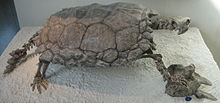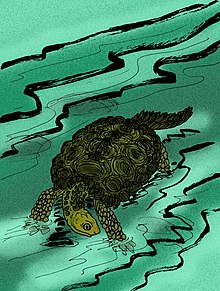Proganochelys
| Proganochelys | |
|---|---|

| |
| Skeleton of Proganochelys quenstedti, American Museum of Natural History | |
| Scientific classification | |
| Domain: | Eukaryota |
| Kingdom: | Animalia |
| Phylum: | Chordata |
| Class: | Reptilia |
| Clade: | Pantestudines |
| Clade: | Testudinata |
| Genus: | †Proganochelys Baur , 1887
|
| Species: | †P. quenstedti
|
| Binomial name | |
| †Proganochelys quenstedti Baur , 1887 | |
| Synonyms | |
| |
Proganochelys is a genus of extinct, primitive stem-turtle. Proganochelys was named by
Proganochelys is the oldest stem-turtle species with a complete shell discovered to date, known from fossils found in Germany, Switzerland, Greenland, and Thailand in strata from the late Triassic, dating to approximately 210 million years ago.[2] The location of these fossils suggest that Proganochelys was active throughout the continent of Laurasia. There are only two known species of Proganchelys, with little information as a result of a small fossil record. All Proganochelys quentesti fossils were discovered in Germany, while Proganochelys ruchae fossils were found in Thailand.
Psammochelys, Stegochelys, and Triassochelys are junior synonyms of Proganochelys. Chelytherium von Meyer, 1863 has been considered a synonym of Proganochelys by some authors, but Joyce (2017) considers it a nomen dubium given the fragmentary nature of the syntype material. Joyce (2017) also considered North American genus Chinlechelys to be a junior synonym of Proganochelys, though the author maintains the type species of the former genus, C. tenertesta, as a distinct species within the genus Proganochelys.[3]
Description and paleobiology


Proganochelys was once considered to be the oldest known stem-turtle until the description of
Synapomorphies and autapomorphies
Proganochelys possess a few chelonian
Shell

The broadened
Skull
The dermal roofing elements of Proganochelys include a large

Discovery
The earliest fossils of Proganochelys were discovered in Germany in the rural towns of Halberstadt, Tübingen, and Trossingen.[11] The fossils were found in an elaborate formation of shales, sandstones, and some limestone piles, with the formation believed to be between 220 and 205 million years old.[11] Consensus among Geologists placed the fossils in the middle of the Norian, around 210 million years ago, although this is largely an estimate.[11] In addition to Proganochelys, the rock formations in Germany have also given fossils for the stem-turtle Proterochersis.[6] Fossils have also been found the Klettgau Formation of Switzerland.[12]
Paleoecology
The specific ecology of the Late Triassic stem-turtles has been disputed and a major point of disagreement for many years among scientists.[13] Triassic stem-turtles, including Proganochelys, appear to have been both aquatic and terrestrial.[13] Shell proportions are believed to be correlated to the environment in which a turtle lives in, seen in modern turtles today. Using this concept, scientists were able to infer on the habitat in which Proganochelys may have lived in. A comparison between modern turtles and Proganochelys found that it was not likely that stem-turtles had differentiated into specialized ecologies such as open water swimmers or solely terrestrial turtles in the Late Triassic period.[13] If this is the case, a freshwater habitat would be the most likely environment for Proganochelys to have lived in. On the other hand, it is noted that some believe Proganochelys were solely terrestrial. Shell bone histology of extant turtles revealed congruence with terrestrial turtles for the earliest basal turtles, including Proganochelys, taxa in one study.[14] The common ancestry of all living turtles is believed to be aquatic, while the earliest turtles are believed to have lived in a terrestrial environment.[15]
Environment and forelimbs
Forelimbs are believed to be a physical feature that reflects the preferences and adaptations to a specific environment, indicating the environment a turtle would be most likely to reside in. Based on morphological data, Proganochelys is believed to have lived in a semi-aquatic environment,[15] though a 2021 study groups it with tortoises and other terrestrial taxa.[16] Turtles possessing short hands are believed to be most likely terrestrial, while turtles with long limbs are more likely to be aquatic.[15] The majority of all testudines are short-handed and terrestrial, while all cheloniods are long-handed and aquatic.[15]
Classification
Proganochelys belongs to the group of tetrapods with a shell known as Testudinata and is the oldest primitive stem turtle. The group does not include Odontochelys.
The cladogram below follows an analysis by Jérémy Anquetin (2012).[17]
| |||||||||||||||||||||||||||||||||||||||||||||||||||||||||||||||||||
Habitat
Proganochelys is considered to have lived in the giant
References
- ^ S2CID 4405644.
- ISBN 9780231539425.
- S2CID 54982901.
- ISBN 9781421428680.
- ISBN 978-1-84028-152-1.
- ^ .
- .
- ^ PMID 20534602.
- S2CID 205243837.
- S2CID 32907587.
- ^ ISSN 0003-0090.
- PMID 36317153.
- ^ .
- PMID 17519193.
- ^ PMID 15002764.
- S2CID 244700219.
- S2CID 85295987.
